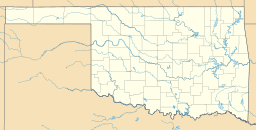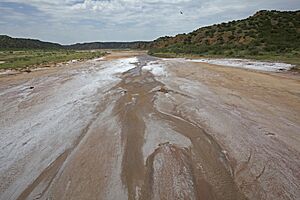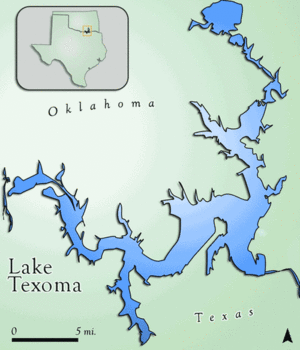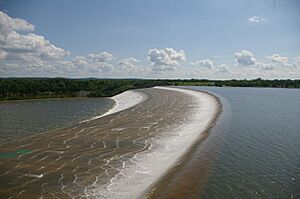Lake Texoma facts for kids
Quick facts for kids Lake Texoma |
|
|---|---|
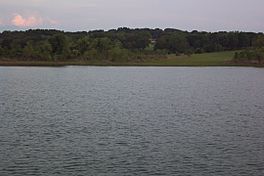
The Oklahoma shores slope toward the water's edge
|
|
| Location | Oklahoma–Texas border, United States |
| Coordinates | 33°49′55″N 96°34′16″W / 33.83194°N 96.57111°W |
| Lake type | reservoir |
| Primary inflows | Red River, Washita River |
| Primary outflows | Red River |
| Catchment area | 39,719 sq mi (102,870 km2) |
| Basin countries | United States |
| Surface area | 89,000 acres (36,000 ha) |
| Water volume | 2,525,568 acre⋅ft (3.115242 km3) |
| Surface elevation | 615 to 619 ft (187 to 189 m) |
| Settlements | Denison, Sherman, Gainesville (Texas);, Kingston, (Oklahoma) |
Lake Texoma is one of the largest reservoirs (man-made lakes) in the United States. It's the 12th-biggest lake managed by the US Army Corps of Engineers (USACE) and the largest in their Tulsa area. Lake Texoma was created by the Denison Dam on the Red River.
The dam is located in Bryan County, Oklahoma, and Grayson County, Texas. It's about 5 miles (8.0 km) northwest of Denison, Texas, and 15 miles (24 km) southwest of Durant, Oklahoma. The lake project was finished in 1944. Lake Texoma is super popular, attracting around 6 million visitors every year! Most of the lake is actually within Oklahoma's borders.
Contents
How the Lake Works
Rivers and Outlets
Lake Texoma gets its water mainly from two rivers: the Red River from the west and the Washita River from the north. Other smaller streams also flow into it, like Big Mineral Creek and Buncombe Creek. The water from Lake Texoma then flows out into the Red River through the Denison Dam.
Water Levels
The normal water level of Lake Texoma usually stays between 615 to 619 ft (187 to 189 m) above sea level. This level can change depending on the time of year. During floods, the lake can hold water up to 645 ft (197 m).
The lake has reached very high levels and flowed over the dam's special overflow area (spillway) five times. This happened in 1957, 1990, 2007, and twice in 2015. On June 1, 2015, the lake reached its highest level ever recorded at 645.72 feet. The very top of the Denison Dam is at 670 feet.
Salty Water from the Red River
The Red River, which helps form Lake Texoma, is a bit salty. This is because of old salt deposits left over from a sea that was here about 250 million years ago! Over time, this ancient sea dried up, leaving behind lots of salt, mostly sodium chloride (table salt).
Even though rocks and dirt now cover these deposits, the salt still slowly dissolves and flows into the Red River. This means that as much as 3,450 tons of salt can flow into the river every day! Because of this, the water in the Red River can be too salty for some uses.
This unique salty water allows striped bass, a type of fish that usually lives in the ocean, to live and thrive in Lake Texoma. In fact, Lake Texoma is the only place in Texas where striped bass can reproduce and live on their own without help.
Lake Texoma's Location
Lake Texoma is located right on the border between Oklahoma and Texas. In Oklahoma, it touches Bryan, Marshall, Johnston, and Love counties. In Texas, it's next to Grayson and Cooke counties.
The lake covers a huge area of 89,000 acres (about 360 square kilometers). It holds a lot of water, with a normal volume of 2,525,568 acre⋅ft (3.115242 km3).
Nearby Cities
Some of the main cities near the lake in Texas are Denison, Sherman, and Gainesville. In Oklahoma, the biggest city nearby is Durant.
Other towns and communities close to the lake include Kingston and Madill in Oklahoma, and Pottsboro and Gordonville in Texas.
Islands to Explore
Lake Texoma has several small islands that you can only reach by boat. Some of these islands have fun names like West Island, Wood Island, Hog Island, Treasure Island, Little Island, and North Island.
Parks Around the Lake
You'll find two state parks at Lake Texoma: Lake Texoma State Park in Oklahoma and Eisenhower State Park in Texas. There are also 54 parks managed by the United States Army Corps of Engineers (USACE). At both ends of the lake, there are National Wildlife Refuges, which are special places for animals.
Lake Texoma's History
Lake Texoma has become more and more important over the years. At first, it was built to stop yearly floods. Then, it helped create jobs for people in the area. Now, it's a huge place for fun and recreation for people from all over the country.
A man named George Moulton, a businessman from Denison, dreamed of building a dam on the Red River way back in 1925. He started talking to local business groups in the late 1920s. Later, Sam Rayburn, a politician, joined the effort in the 1930s and helped make the lake a reality through new laws.
The government approved money for the Denison Dam in 1938. The U.S. Army Corps of Engineers then set up an office to manage the project.
Building the Dam During WWII
Lake Texoma was built during World War II. Interestingly, German prisoners of war (POWs) helped with the construction of the dam. These prisoners were from Rommel's Afrika Korps and were held in camps nearby.
According to rules like the Geneva Convention, POWs could only do work that wasn't related to the war. So, they helped clear trees for the future lake and did light construction. For example, they built stone walls for drainage ditches around the dam, which you can still see today.
The dam was finished in January 1944. It cost about $54 million back then. The two power generators were added later, in September 1949. Originally, Lake Texoma was meant to control floods, produce electricity, and provide water. It wasn't until 1988 that recreation was officially added as a purpose by Congress.
For a few years, from 1946 to 1949, the National Park Service (NPS) helped manage the land around Lake Texoma. However, they decided to leave, and the U.S. Army Corps of Engineers took over all the operations and maintenance.
In June 2015, the lake got a lot of attention when a huge whirlpool, about 2.5 meters wide, formed as water was drained after a flood.
Why Lake Texoma is Popular
Lake Texoma is very popular because it's so big and it's close to the Dallas-Fort Worth Metroplex (a large city area). It's only about an hour's drive north from there. The area around Lake Texoma, sometimes called Texoma or Texomaland, is growing fast because so many tourists visit.
Fun Things to Do
Lake Texoma offers many different ways to have fun! You can visit two wildlife refuges, two state parks, and 54 parks managed by the USACE. There are also 12 marinas (places to dock boats), 26 resorts, and many campgrounds. You can also find several golf courses.
Popular activities include power boating, sailing, using personal watercraft, water skiing, and wind surfing. The lake is a major spot for sailing because it's so big and has many miles of shoreline perfect for it.
During spring break and Fourth of July holidays, many college students gather in an area called "Fobb Bottom" on the Oklahoma side of the lake.
Lake Texoma also hosts the Lakefest Regatta, which is thought to be the first charity sailing race held on an inland lake in the United States. This event usually brings together up to 100 sailboats and more than 500 sailors each spring. Since it started, Lakefest has raised over $2 million for different children’s charities. Right now, the money goes to the Make-A-Wish Foundation® of North Texas.
Fishing Fun
In 2004, a huge blue catfish weighing 121.5 pounds (55.1 kg) was caught in Lake Texoma! This temporarily set a world record for a catfish caught with a rod and reel. The fish was later moved to a special aquarium. More commonly, catfish in Lake Texoma weigh between 5 and 70 pounds (2.3 and 31.8 kilograms).
Camping Adventures
There are many campgrounds, both public and private, along the shores of Lake Texoma. These include Eisenhower State Park, named after President Dwight Eisenhower who was born nearby. You can also find Camp All Saints, owned by the Episcopal Diocese of Dallas, and James Ray Scout Reservation, which belongs to the Boy Scouts of America.
Fees
To help pay for maintenance and improvements, the State of Oklahoma started charging a small fee to some visitors at Lake Texoma State Park starting June 15, 2020.
New Developments
Recently, some parts of the public land around Lake Texoma have been approved to be sold to private companies for new projects.
For example, a law in 1999 allowed the USACE to sell about 1,580 acres (6.4 km2) of land on the north shore of Lake Texoma in Oklahoma to the state. This land was part of Lake Texoma State Park. The state then made a deal with a company called Pointe Vista Development, LLC, to sell them about 750 acres for building new homes and a fancy resort.
This new development is planned to include golf courses, a water park, outdoor recreation areas, nature parks, campgrounds, shops, and an amphitheater. It will also have housing and a full-service hotel with restaurants, a gym, swimming pools, and meeting rooms. The new private community is expected to have 250–350 high-end homes.
The old Lake Texoma Lodge, built in 1951, closed in 2006 because it was in bad shape. It has since been torn down.
Another law in 2007 allowed the USACE to give about 900 acres (3.6 km2) of land at Lake Texoma to the city of Denison, Texas. The city plans to sell this land to a local developer to create a private neighborhood and recreation area. This new development could bring as many as 10,000 new residents to the Grandpappy Point area.


